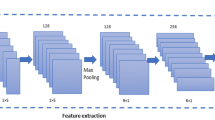Abstract
Gait recognition is a well-known biometric identification technology and is widely employed in different fields. Due to the advantages of deep learning, such as self-learning capability, high accuracy and excellent generalization ability, various deep network algorithms have been applied in biometric recognition. Numerous studies have been conducted in this area; however, they may not always yield the expected outcomes owing to the issue of data imbalance in clinical and healthcare industries. To overcome this problem, deep multi-convolutional stacked capsule network fostered human gait recognition from enhanced gait energy image (HGR-DMCSCN) is proposed in this manuscript. Initially, the input images are taken from CASIA B and OU-ISIR datasets. Then the input images are given to preprocessing segment to enhance the superiority of the images based upon contrast-limited adaptive histogram equalization filtering (CLAHEF). Then preprocessed image is given to classification process using deep multi-convolutional stacked capsule network (DMCSCN) that is utilized for human gait detection under various conditions, like normal walking, carrying a bag and wearing a cloth. The proposed HGR-DMCSCN approach is executed in python and its performance is examined under performance metrics, such as F-Score, accuracy, RoC and computational time. Finally, the proposed approach attains 28.70%, 11.87% and 14.79% higher accuracy for CASIA B compared with existing methods.










Similar content being viewed by others
References
Premalatha, G., Chandramani, V., P.: Improved gait recognition through gait energy image partitioning. Comput. Intell. 36(3), 1261–1274 (2020)
Yao, L., Kusakunniran, W., Wu, Q., Zhang, J., Tang, Z., Yang, W.: Robust gait recognition using hybrid descriptors based on skeleton gait energy image. Pattern Recogn. Lett. 150, 289–296 (2021)
Gupta, S. K., Sultaniya, G. M., Chattopadhyay, P.: An efficient descriptor for gait recognition using spatio-temporal cues. In Emerging Technology in Modelling and Graphics: Proceedings of IEM Graph 2018 (pp. 85–97). Springer Singapore. (2020).
Asif, M., Tiwana, M.I., Khan, U.S., Ahmad, M.W., Qureshi, W.S., Iqbal, J.: Human gait recognition subject to different covariate factors in a multi-view environment. Results Eng. 15, 100556 (2022)
Guo, H., Li, B., Zhang, Y., Zhang, Y., Li, W., Qiao, F., Zhou, S.: Gait recognition based on the feature extraction of Gabor filter and linear discriminant analysis and improved local coupled extreme learning machine. Mathematical Problems in Engineering, 2020. (2020).
Saleem, F., Khan, M.A., Alhaisoni, M., Tariq, U., Armghan, A., Alenezi, F., Kadry, S.: Human gait recognition: A single stream optimal deep learning features fusion. Sensors 21(22), 7584 (2021)
Chou, F.I., Tsai, Y.K., Chen, Y.M., Tsai, J.T., Kuo, C.C.: Optimizing parameters of multi-layer convolutional neural network by modeling and optimization method. IEEE Access 7, 68316–68330 (2019)
Jebadass, J.R., Balasubramaniam, P.: Low contrast enhancement technique for color images using interval-valued intuitionistic fuzzy sets with contrast limited adaptive histogram equalization. Soft. Comput. 26(10), 4949–4960 (2022)
Jasper Gnana Chandran, J., Karthick, R., Rajagopal, R., Meenalochini, P.: Dual-channel capsule generative adversarial network optimized with golden eagle optimization for pediatric bone age assessment from hand X-ray image. Int. J. Pattern Recog. Artif. Intell. 37(02), 2354001 (2023)
Shajin, F. H., Aruna Devi, B., Prakash, N. B., Sreekanth, G. R., Rajesh, P.: Sailfish optimizer with Levy flight, chaotic and opposition-based multi-level thresholding for medical image segmentation. Soft Comput. 1–26. (2023).
Rajesh, P., Shajin, F.: A multi-objective hybrid algorithm for planning electrical distribution system. Eur. J. Electr. Eng. 22(4–5), 224–509 (2020)
Shajin, F. H., Rajesh, P., Raja, M. R.: An efficient VLSI architecture for fast motion estimation exploiting zero motion prejudgment technique and a new quadrant-based search algorithm in HEVC. Circuits, Systems, and Signal Processing, 1–24. (2022).
Rajesh, P., Kannan, R., Vishnupriyan, J., Rajani, B.: Optimally detecting and classifying the transmission line fault in power system using hybrid technique. ISA Trans. 130, 253–264 (2022)
Khan, M. A., Arshad, H., Damaševičius, R., Alqahtani, A., Alsubai, S., Binbusayyis, A., Kang, B. G.: Human gait analysis: A sequential framework of lightweight deep learning and improved moth-flame optimization algorithm. Computational intelligence and neuroscience, 2022. (2022).
Wang, Y., Zhang, X., Shen, Y., Du, B., Zhao, G., Cui, L., Wen, H.: Event-stream representation for human gaits identification using deep neural networks. IEEE Trans. Pattern Anal. Mach. Intell. 44(7), 3436–3449 (2021)
Gul, S., Malik, M.I., Khan, G.M., Shafait, F.: Multi-view gait recognition system using spatio-temporal features and deep learning. Expert Syst. Appl. 179, 115057 (2021)
Mogan, J.N., Lee, C.P., Lim, K.M., Muthu, K.S.: VGG16-MLP: gait recognition with fine-tuned VGG-16 and multilayer perceptron. Appl. Sci. 12(15), 7639 (2022)
Wang, X., Yan, W.Q.: Human gait recognition based on frame-by-frame gait energy images and convolutional long short-term memory. Int. J. Neural Syst. 30(01), 1950027 (2020)
Wang, X., Zhang, J., Yan, W.Q.: Gait recognition using multichannel convolution neural networks. Neural Comput. Appl. 32(18), 14275–14285 (2020)
Acknowledgements
None.
Funding
None.
Author information
Authors and Affiliations
Contributions
PN (corresponding author) was responsible for conceptualization, methodology and original draft preparation. MFU was involved in supervision.
Corresponding author
Ethics declarations
Conflict of interest
The authors declare no competing interests..
Additional information
Publisher's Note
Springer Nature remains neutral with regard to jurisdictional claims in published maps and institutional affiliations.
Rights and permissions
Springer Nature or its licensor (e.g. a society or other partner) holds exclusive rights to this article under a publishing agreement with the author(s) or other rightsholder(s); author self-archiving of the accepted manuscript version of this article is solely governed by the terms of such publishing agreement and applicable law.
About this article
Cite this article
Nithyakani, P., Ferni Ukrit, M. Deep multi-convolutional stacked capsule network fostered human gait recognition from enhanced gait energy image. SIViP 18, 1375–1382 (2024). https://doi.org/10.1007/s11760-023-02851-1
Received:
Revised:
Accepted:
Published:
Issue Date:
DOI: https://doi.org/10.1007/s11760-023-02851-1




